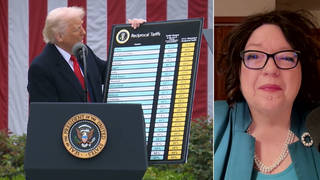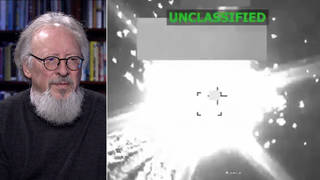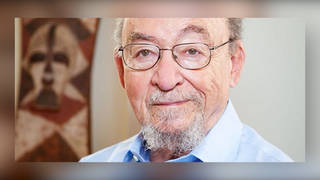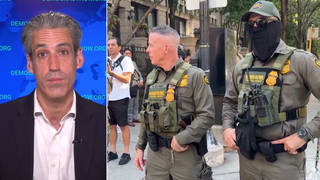
We speak with Colorado University professor Len Ackland about the former plutonium-processing Rocky Flats nuclear bomb making plant. Ackland is author of the book Making A Real Killing: Rocky Flats and the Nuclear West that examines the four-decade history of Rocky Flats. [includes rush transcript]
Democracy Now! is broadcasting today from the studios of Free Speech TV in Boulder, Colorado. Just eight miles south of here lies the former plutonium-processing Rocky Flats nuclear weapons plant, next to that is The Rocky Mountain Arsenal–a former chemical weapons plant where deadly sarin, mustard gas and napalm were manufactured. Not far from there lies a sprawling 480-acre toxic waste site known as the Lowry landfill.
Over the last half century, Colorado has been the center of the U.S. nuclear weapons programs–within the state alone there are 49 active underground missile silos each. Today we will look at the history of this area in relation to the military industrial complex and its impact on the future.
Rocky Flats was built in the early 1950s to produce plutonium warhead triggers for nuclear weapons. It closed four decades later when the FBI raided the plant in 1989 to investigate allegations of environmental crimes. But Rocky Flats reentered the news recently with the publication of a new book called “The Ambushed Grand Jury.”
This was no ordinary account. It was an inside look by a Colorado rancher named Wes McKinley who has spent a dozen years serving on a grand jury investigation of a nuclear cover-up at the site that involved the Justice Department.
Meanwhile there is growing concern over plans to reuse sites like Rocky Flats and to recycle water and sludge from a landfill that some say is contaminated with radioactivity.
We begin with taking a look at the history of Rocky Flats.
- Len Ackland, professor of journalism at the University of Colorado at Boulder and the author of the book Making A Real Killing: Rocky Flats and the Nuclear West.
Transcript
AMY GOODMAN: We’re going to talk to Len Ackland Professor of Journalism at University of Colorado, Boulder and author of the book “Making a Real Killing: Rocky Flats and the Nuclear West.” Welcome to Democracy Now! Its great to have you and its great to be here in Boulder. Talk about — for people not familiar with Rocky Flats, put it in context. Just how big is it — how significant is it in US history?
LEN ACKLAND: Rocky Flats was established in 1951 when the United States made a decision to build up its nuclear weapons arsenals and needed a factory that would mass produce plutonium bombs and those plutonium bombs became detonators for thermonuclear bombs. The plutonium bomb that we’re talking about is equivalent to the bomb that destroyed Nagasaki. So in terms of thermonuclear weapons which are about a thousand times more explosive than the bomb that destroyed Nagasaki, the plutonium bombs are “relatively small” and they’re used to trigger these bombs. So Rocky Flats came into being. The headline on the Denver Post the morning after, the afternoon after the press conference was held read: “There’s Good News Today. US to Build $40 Million A-Bomb Plant.” So this was regarded as a jobs creator for the Denver area and indeed, over the next four decades billions of dollars went into the Denver economy. The problem was that for much of that period, especially the first part of the period, the people didn’t realize that there were releases from Rocky Flats, there were fires that had taken place, plutonium fires. In 1969 on Mothers Day in say 35 years ago, a plutonium building containing 7000 lb of plutonium caught fire. Plutonium, one of its other delightful aspects, is that it combusts spontaneously in air. So the plutonium fire burned, the building nearly collapsed, the roof nearly went off, and even a government official a year later said we came close to losing that building, and if that had happened, hundreds of square miles would have been contaminated. So you had very high risk at Rocky Flats, you had regular releases of plutonium that were monitored. You had waste that was stored outside in barrels — something called the 903 pad. The winds distributed that plutonium off site at Rocky Flats so you know you basically had a situation where we had both a local hazard and a global threat.
AMY GOODMAN: So lets talk about what’s happened — secret midnight burning of radioactive waste and FBI spy flight with infrared cameras. I wanted to bring Wes McKinley into this conversation, a Colorado rancher and the foreman of the Grand Jury that investigated activity at Rocky Flats. He is co-author of “Ambushed Grand Jury: How the Justice Department Covered Up Government Nuclear Crimes and How We Caught Them Red-handed” Can you talk about — on the one had we have Len Ackland talking about the history — how did the plant close and how did you get involved. How did this whole Grand Jury get involved?
WES MCKINLEY: Hello this is Wes McKinley.
AMY GOODMAN: Hi Wes McKinley.
WES MCKINLEY: How you doing this morning?
AMY GOODMAN: Very good to have you with us.
WES MCKINLEY: Thanks, thanks. Well the way I got involved is that I received a letter in the mail one day to report to Grand Jury duty. Grand Jury is selected from the citizens of Colorado, and I was randomly selected to be on that. No special talents or ability did I bring to it, strictly random selection, and after about 3 or 4 months into it I became the foreman–kind of by default–the other foreman resigned, couldn’t do it. So we heard all the testimony like you just said. That was part of the allegations, and we heard all of those things over a course of three years
AMY GOODMAN: It was three years–Adrienne Anderson also joining us, Professor of Environmental and Ethnic studies at the University of Colorado, Boulder
ADRIENNE ANDERSON: Mr. McKinley and his other cohorts in the Grand Jury were convened from 1989 to '92 to look at purported criminal activity at the Rocky Flats nuclear weapons plant and as their book chronicles, the US Justice Department actually sold them down the river. At the end of their term of service, Mike Norton, then the US Attorney for this region, essentially cut a deal with Rockwell International that would not give them any criminal liability which is what the grand jurors sought, but instead would fine them several million dollars and then they'd be off the hook for any other types of liability. And now the concern is what’s being done with the Rocky Flats Nuclear Weapons Plant–whether it has been adequately cleaned up. Many of us in this region and around the country say no it is not — and in fact we believe that there is an effort to suppress information about the extent of plutonium contamination of that area, the extent of offsite contamination by plutonium — in fact Dr. Helen Caldicott, who founded the physicians for social responsibility, has said publicly that she believes the entire Denver metropolitan area should not be inhabited because of the disposition of plutonium that occurred from the fires in 1957 and 1969. But its actually worse than that because Rocky Flats was also hauling waste offsite up to 30 miles away from the Rocky Flats Plant here near Boulder. It was actually hauling it out to Eastern Colorado in a dump site called the Lowry Landfill taking tons of waste — there’s two tons of plutonium missing from the Rocky Flats nuclear weapons plant, missing and unaccounted for, the government admits, and in an investigation that I’ve been involved in since 1996 on behalf of sewage plant workers, we’ve unraveled a troubling tale of the fact that Rocky Flats was taking waste to this dump, Lowry Landfill, which is now a Superfund site, and secretly, the polluters at the site, with the government, entered into a deal where they would flush it into public sewer lines and then from there it would be trucked out and used as farm fertilizer on agricultural fields out in Eastern Colorado that are growing food crops for America. And furthermore, just in recent months they’ve also concocted a plan where they’re taking the water from the sewage facility that is co-mingled with the Lowry Landfill waste that does include radioactive waste, and its being re-routed now onto parks in Denver, playgrounds in Denver and starting this month, it’s even going to be used as irrigation water at the Denver zoo. And this is the only place in the United States of America where there’s been a permit issued to allow plutonium and other nuclear waste to be released from the Superfund site for end use as farm fertilizer and recycled water to irrigate public parks and recreation areas — unprecedented anywhere else in the country. The only other place where the EPA is trying to do this is in New Jersey, at a Superfund site there, and the Governor of New Jersey is standing up, screaming about this. They’re fighting over this in court.
AMY GOODMAN: Where is this Superfund site?
ADRIENNE ANDERSON: Its called the Gems landfill in Camden County New Jersey and there’s tremendous newspaper coverage of this in New Jersey, yet here, the Denver Post and the Rocky Mountain News have refused to report about the documented evidence about this. Dean Singleton, who is the head of the media news group here, in our investigation is part of the problem, part of the deal. And the deal was that the polluters paid into a common fund secretly and the Denver Post and Rocky Mountain News, our two major newspapers here both had dumped toxic waste at Lowry Landfill as well. And when the concern…
AMY GOODMAN: Well can I ask you to…
ADRIENNE ANDERSON: Well they had dumped printing inks and solvents and sometimes those can contain PCB’s. They dumped a relatively small amount given what Coor’s dumped, who was the top polluter at the site, and other companies–including Martin Marietta from the Titan Missile factory here, the Rocky Mountain Arsenal dumped waste at Lowry Landfill and trucking records showed that Rocky Flats for years took waste out there as well — unidentified waste. The problem though, is that the newspapers, as jointly liable parties at the Superfund site, they themselves had done a secret deal to pay into a fund. This was revealed by Pulitzer-prize winning investigative reporter Eileen Wilson and its been reported about in a three-part series called “Dirty Secrets.”
AMY GOODMAN: Eileen Wilson is the reporter from Albuquerque who exposed the nuclear experiments on people all over the country unknown to them over decades —
ADRIENNE ANDERSON: Yes —-—
AMY GOODMAN: the injection…
ADRIENNE ANDERSON: Yes she did her very excellent file, book, “The Plutonium Files” is required reading for my students on campus. But Miss Wilson and I had worked together about the evidence around this and found that the newspapers had engaged in these secret deals as well, and the newspapers knew that radioactive premiums were being offered to the polluters to escape liability for the radioactive component of Lowry Landfill and then shoveling…
AMY GOODMAN: what do you mean?
ADRIENNE ANDERSON: Well, the polluters at the site — the City of Denver owns the Superfund site. It was also operated by Waste Management Inc. which has been associated with organized crime around the country. Those two parties together created the secret trust and then went and asked corporations to pay into the fund to help them with the cleanup at the site. The newspapers were part of that deal and the city and Waste Management Inc. offered radioactive premiums that if the companies would pay a radioactive premium then they would be held harmless and off the hook if and when the public learned that the site was radioactive with plutonium and other waste. Dean Singleton at the Denver Post did not pay a radioactive premium and so therefore if the public were to be effective in urging that there be a more effective cleanup to handle the nuclear waste component of the superfund site then the newspapers would also be on the hook for that liability and so they have had a disinterest in reporting the evidentiary trail that we’ve discovered about the plutonium at the site.
AMY GOODMAN: Well I want to ask our journalism professor about this but we have to break for a minute were talking to Adrienne Anderson who is Professor of Environmental and Ethnic Studies at the University of Colorado, Boulder also Western director of the National Toxics Campaign which is a network of community groups that studies toxins in their communities. We are also talking to Wes McKinley, a Colorado rancher, and the foreman of a Grand Jury that investigated Rocky Flats and Len Ackland, Professor of Journalism from the University of Colorado. Stay with us.












Media Options